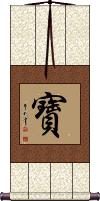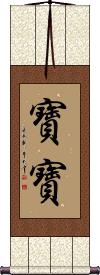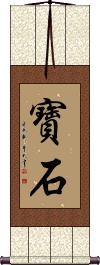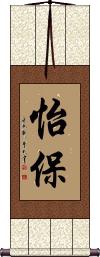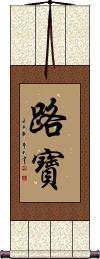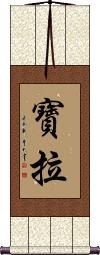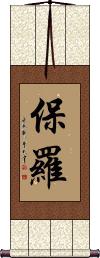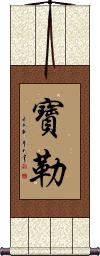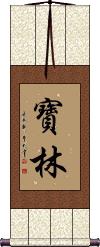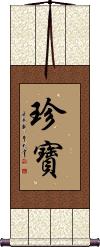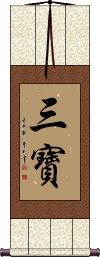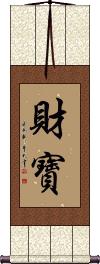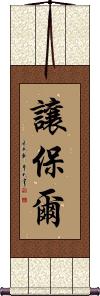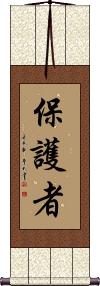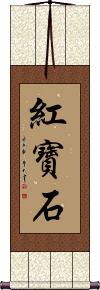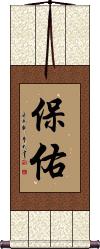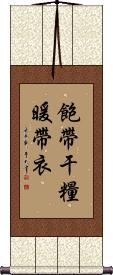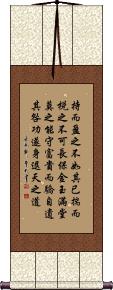Many custom options...
And formats...

Bao3 in Chinese / Japanese...
Buy a Bao3 calligraphy wall scroll here!
Personalize your custom “Bao3” project by clicking the button next to your favorite “Bao3” title below...
1. Treasure
2. Baby
3. Gem
4. Ipoh
5. Lobo
6. Paola
7. Paolo
8. Paul
9. Paula
10. Paule
11. Pauline
12. Paulo
13. Paulyn
14. Pola
15. Treasure
16. Pauly
17. Paulk
18. Paulin
19. Three Treasures of Buddhism
20. Treasure
21. Pauley
22. Burger
23. Jean-Paul
24. Luxembourg
25. Paulina
26. Paulino
27. Paul-Loup
28. Protector
29. Ruby
30. Sapphire
31. Paulsen
32. Paulson
33. Paulus
34. Goldberg
36. Brandenburg
37. Bulgaria
38. Fortnite
39. God Bless You / May God Protect You
40. John-Paul
41. Polyana
42. Take Refuge in the Three Treasures
43. Paulinus
45. Fierce and courageous training defeats the strong and protects the body.
Treasure
寶 means precious thing or treasure.
This can also mean precious, a gem, a pearl, or anything valuable.
![]() The version of this character shown to the left is the traditional Chinese and ancient/traditional Japanese version. In modern Japan and China, this character has been simplified. This simplified version is shown to the right. If you want this modern Japanese/simplified version, just click the Kanji on the right, instead of the button above. If your audience is Chinese or Korean, I recommend the ancient/traditional form. Only consider the simplified form if your audience is younger Japanese people.
The version of this character shown to the left is the traditional Chinese and ancient/traditional Japanese version. In modern Japan and China, this character has been simplified. This simplified version is shown to the right. If you want this modern Japanese/simplified version, just click the Kanji on the right, instead of the button above. If your audience is Chinese or Korean, I recommend the ancient/traditional form. Only consider the simplified form if your audience is younger Japanese people.
Baby
寶寶 is how Chinese people express “baby.”
The word is composed of the same character twice, and therefore literally means “double precious” or “double treasure.”
This would be a nice wall scroll to put either inside or by the door of your baby's room (not on the door, as wall scrolls swing around wildly when hung on doors that open and close a lot).
Ipoh
Lobo
Paola
Paolo
Paul
Paula
Paule
Pauline
Paulo
Paulyn
Pola
Treasure
In Chinese, 珍寶 means treasure, something you value highly, or something very precious to you.
In Japanese, 珍寶 has a meaning like “rare treasure.”
珍 can mean a precious thing or treasure. 寶 can mean a jewel or gem, a treasure, or simply precious. Together these two characters reinforce each other into a word that clearly means treasure.
Pauly
Paulk
Paulin
Three Treasures of Buddhism
The Triple Gem
三寶 is the title for “Three Precious Treasures of Buddhism” or “The Triple Gem.”
These three treasures are the Buddha 佛, the Dharma 法 (teachings or the law of the Buddha), and the Sangha 僧 (the community of monks or followers).
This term is used by most (perhaps not all) Buddhists in China, Japan, and South Korea (written the same in the original form but pronounced differently in each language). Non-Buddhists may just read this as “Three Treasures” without the religious context. For instance, there is also a “Three Treasures of Chinese Medicine” that is sometimes titled the same way.
In modern Japanese and Simplified Chinese, this is written 三宝 instead of 三寶.
Treasure
財寶 is the Japanese word meaning “treasure” or “money and valuables.”
The first character means “property,” “money,” “wealth,” or “assets.” The second character means “treasure,” “wealth,” or “valuables” in Japanese. Together these two characters reinforce each other into a word that clearly means treasure in Japanese.
財寶 is also a word meaning “money and valuables” in Chinese but more of a daily use word - not as appropriate for a wall scroll if your audience is Chinese.
![]() The second character shown to the left is the ancient/traditional Japanese version. In modern Japan, this character has been simplified. This simplified version is shown to the right. If you want this modern Japanese/simplified version, just click the Kanji on the right, instead of the button above.
The second character shown to the left is the ancient/traditional Japanese version. In modern Japan, this character has been simplified. This simplified version is shown to the right. If you want this modern Japanese/simplified version, just click the Kanji on the right, instead of the button above.
Pauley
Burger
Jean-Paul
Luxembourg
This is the Chinese name for the country of Luxembourg.
See Also: Netherlands | Belgium | Europe
Paulina
Paulina
Paulino
Paul-Loup
Protector
保護者 is the universal word for protector in Chinese, Japanese Kanji, and old Korean Hanja.
The first character means to defend, to protect, to insure or guarantee, to maintain, hold or keep, or to guard.
The second character means to protect.
Together the first and second characters create a word that means to defend, protect, or safeguard.
The last character means person.
Add all three characters together, and you have a word that means “protector,” one who will protect, guard, and keep you safe.
Some will also translate this word as guardian or patron.
Note: Not a common selection for a wall scroll in Asia.
See Also: Guardian Angel
Ruby
Sapphire
Paulsen
Paulson
Paulus
Goldberg
Blessings and Protection
保佑 is the more religious and sometimes superstitious word for protection in Chinese. It's sort of a blessing of protection and is often translated as “bless and protect,” “blessing,” or “to bless.”
This would be used as the protection or blessing that a deity (such as God) would bestow upon you. It is not religion-specific in the same way a language cannot be specific to any religion.
![]() Note: Sometimes the second character is written in the form shown to the right. Let us know if you have a preference when you place your order.
Note: Sometimes the second character is written in the form shown to the right. Let us know if you have a preference when you place your order.
See Also: Guardian Angel
Brandenburg
Bulgaria
Fortnite
God Bless You / May God Protect You
上帝保佑 is a blessing exchanged between Chinese Christians.
The first two characters mean God (The God of Zion). The second two characters express the idea of giving protection. Another way to translate this is “May God protect you.”
See Also: Guardian Angel
John-Paul
Polyana
Take Refuge in the Three Treasures
Take Refuge in the Three Treasures
Paulinus
Always Be Prepared
Fierce and courageous training defeats the strong and protects the body.
Daodejing / Tao Te Ching - Chapter 9
This text is the ninth chapter of the Daodejing / Tao Te Ching.
The text reads:
持而盈之、不如其已。揣而梲之、不可長保。 金玉滿堂、莫之能守。 富貴而驕、自遺其咎。 功遂身退、天之道。
This classical Chinese passage comes from the Mawangdui (馬王堆帛書) text.
To hold until full is not as good as stopping.
An oversharpened sword cannot last long.
A room filled with gold and jewels cannot be protected.
Boasting of wealth and virtue brings your demise.
After finishing the work, withdraw.
持而盈之不如其已揣而梲之不可長保金玉滿堂莫之能守富貴而驕自遺其咎功遂身退天之道 is the Way of Heaven.
Dr. Muller's translation of all 81 Daodejing chapters
Not the results for bao3 that you were looking for?
Below are some entries from our dictionary that may match your bao3 search...
| Characters If shown, 2nd row is Simp. Chinese |
Pronunciation Romanization |
Simple Dictionary Definition |
寶 宝 see styles |
bǎo bao3 pao takara たから |
More info & calligraphy: Treasuretreasure; (surname) Takara ratna, precious, a treasure, gem, pearl, anything valuable; for saptaratna v. 七寶. Also maṇi, a pearl, gem. |
三寶 三宝 see styles |
sān bǎo san1 bao3 san pao sanbou / sanbo さんぼう |
More info & calligraphy: Three Treasures of Buddhism(surname) Sanbou three treasures |
保佑 see styles |
bǎo yòu bao3 you4 pao yu yasusuke やすすけ |
More info & calligraphy: Blessings and Protection(given name) Yasusuke |
保羅 保罗 see styles |
bǎo luó bao3 luo2 pao lo pouro / poro ぽうろ |
More info & calligraphy: Paulo(given name) Pouro |
寶寶 宝宝 see styles |
bǎo bao bao3 bao5 pao pao |
More info & calligraphy: Baby |
寶林 宝林 see styles |
bǎo lín bao3 lin2 pao lin Hōrin |
More info & calligraphy: PaulineThe groves, or avenues of precious trees (in the Pure Land). The monastery of Huineng, sixth patriarch of the Chan sect, in 韶州典江縣 Dianjiang Xian, Shaozhou, Guangdong, cf. 慧 15. The 寶林傳 and supplement contain the teachings of this school. |
寶石 宝石 see styles |
bǎo shí bao3 shi2 pao shih |
More info & calligraphy: GemSee: 宝石 |
怡保 see styles |
yí bǎo yi2 bao3 i pao |
More info & calligraphy: Ipoh |
漢堡 汉堡 see styles |
hàn bǎo han4 bao3 han pao hanburugu はんぶるぐ |
More info & calligraphy: Burger(place-name) Hamburg |
珍寶 珍宝 see styles |
zhēn bǎo zhen1 bao3 chen pao chinbō |
More info & calligraphy: TreasureA pearl; jewel; precious thing. |
財寶 财宝 see styles |
cái bǎo cai2 bao3 ts`ai pao tsai pao zaihō |
More info & calligraphy: Treasureriches |
保爾森 保尔森 see styles |
bǎo ěr sēn bao3 er3 sen1 pao erh sen |
More info & calligraphy: Paulson |
保護者 保护者 see styles |
bǎo hù zhě bao3 hu4 zhe3 pao hu che hogosha ほごしゃ |
More info & calligraphy: Protectorguardian; protector; patron; parent |
盧森堡 卢森堡 see styles |
lú sēn bǎo lu2 sen1 bao3 lu sen pao |
More info & calligraphy: Luxembourg |
紅寶石 红宝石 see styles |
hóng bǎo shí hong2 bao3 shi2 hung pao shih |
More info & calligraphy: Ruby |
藍寶石 蓝宝石 see styles |
lán bǎo shí lan2 bao3 shi2 lan pao shih |
More info & calligraphy: Sapphire |
保 see styles |
bǎo bao3 pao yasuji やすじ |
to defend; to protect; to keep; to guarantee; to ensure; (old) civil administration unit in the baojia 保甲[bao3 jia3] system (personal name) Yasuji Protect, ward, guard; guarantee. |
媬 see styles |
bǎo bao3 pao |
governess; nurse |
寳 宝 see styles |
bǎo bao3 pao takara たから |
variant of 寶|宝[bao3] treasure; (surname) Takara v. 寶 20. |
緥 褓 see styles |
bǎo bao3 pao |
variant of 褓[bao3] |
葆 see styles |
bǎo bao3 pao tamotsu たもつ |
dense foliage; to cover (personal name) Tamotsu |
褓 see styles |
bǎo bao3 pao |
used in 襁褓[qiang3 bao3]; used in 褓姆[bao3 mu3] and 褓母[bao3 mu3] |
飽 饱 see styles |
bǎo bao3 pao norikazu のりかず |
to eat till full; satisfied (personal name) Norikazu Replete, full. |
鴇 鸨 see styles |
bǎo bao3 pao houzaki / hozaki ほうざき |
Chinese bustard; procuress (kana only) bustard (esp. the great bustard, Otis tarda); (kana only) Japanese crested ibis (Nipponia nippon); crested ibis; (surname) Houzaki |
一寶 一宝 see styles |
yī bǎo yi1 bao3 i pao ippou / ippo いっぽう |
(surname) Ippou The one precious thing, the spirit, or intelligent nature; the intelligent mind (behind all things). |
七寶 七宝 see styles |
qī bǎo qi1 bao3 ch`i pao chi pao shichihō |
sapta ratna 薩不荅羅的捺 The seven treasures, or precious things, of which there are varying descriptions, e.g. 金 suvarna, gold; 銀rūpya, silver; 鐂璃 vaiḍūrya, lapis lazuli; 玻瓈sphaṭika, crystal; 硨磲 musāragalva, agate; 赤珠 rohita-mukta, rubies or red pearls; 瑪瑙 aśmagarbha, cornelian. Also the seven royal (cakravartin) treasures―the golden wheel; elephants; dark swift horses; the divine pearl, or beautiful pearls; able ministers of the Treasury; jewels of women; and loyal generals. |
三寳 三宝 see styles |
sān bǎo san1 bao3 san pao sanbō |
Triratna, or Ratnatraya, i.e. the Three Precious Ones: 佛 Buddha, 法 Dharma, 儈 Saṅgha, i.e. Buddha, the Law, the Ecelesia or Order. Eitel suggests this trinity may be adapted from the Trimūrti, i.e, Brahma, Viṣṇu, and Sīva. The Triratna takes many forms, e.g. the Trikāya 三身 q.v. There is also the Nepalese idea of a triple existence of each Buddha as a Nirvāṇa-Buddha, Dhyāni-Buddha, and Mānuṣi-Buddha; also the Tantric trinity of Vairocana as Nirvāṇa-Buddha, Locana according to Eitel "existing in reflex in the world of forms", and the human Buddha, Śākyamuni. There are other elaborated details known as the four and the six kinds of triratna 四 and 六種三寳, e.g. that the Triratna exists in each member of the trinity. The term has also been applied to the 三仙 q.v. Popularly the 三寳 are referred to the three images in the main hall of monasteries. The centre one is Śākyamuni, on his left Bhaiṣajya 藥師 and on his right Amitābha. There are other explanations, e.g. in some temples Amitābha is in the centre, Avalokiteśvara on his left, and Mahāsthāmaprāpta or Mañjuśrī on his right. Table of Triratna, Trikāya, and Trailokya: — DHARMASAṄGHABUDDHAEssential BodhiReflected BodhiPractical BodhiDhyāni BuddhaDhyāni BodhisattvaMānuṣī BuddhaDharmakāyaSambhogakāyaNirmāṇakāyaPurityCompletenessTransformations4th Buddha-kṣetra3rd Buddha-kṣetra1st and 2nd Buddha kṣetraArūpadhātuRūpadhātuKāmadhātu. |
中保 see styles |
zhōng bǎo zhong1 bao3 chung pao nakayasu なかやす |
middleman and guarantor mediation; (surname) Nakayasu |
中飽 中饱 see styles |
zhōng bǎo zhong1 bao3 chung pao |
to embezzle; to misappropriate; to line one's pockets with public funds |
久保 see styles |
jiǔ bǎo jiu3 bao3 chiu pao hisayoshi ひさよし |
Kubo (Japanese surname) (male given name) Hisayoshi |
Click here for more bao3 results from our dictionary
The following table may be helpful for those studying Chinese or Japanese...
| Title | Characters | Romaji (Romanized Japanese) | Various forms of Romanized Chinese | |
| Treasure | 寶 宝 | takara | bǎo / bao3 / bao | pao |
| Baby | 寶寶 宝宝 | bǎo bao / bao3 bao / bao bao / baobao | pao pao / paopao | |
| Gem | 寶石 宝石 | bǎo shí / bao3 shi2 / bao shi / baoshi | pao shih / paoshih | |
| Ipoh | 怡保 | yí bǎo / yi2 bao3 / yi bao / yibao | i pao / ipao | |
| Lobo | 路寶 路宝 | lù bǎo / lu4 bao3 / lu bao / lubao | lu pao / lupao | |
| Paola | 寶拉 宝拉 | bǎo lā / bao3 la1 / bao la / baola | pao la / paola | |
| Paolo | 保羅 保罗 | bǎo luó / bao3 luo2 / bao luo / baoluo | pao lo / paolo | |
| Paul | 保羅 保罗 | bǎo luó / bao3 luo2 / bao luo / baoluo | pao lo / paolo | |
| Paula | 寶拉 宝拉 | bǎo lā / bao3 la1 / bao la / baola | pao la / paola | |
| Paule | 寶勒 宝勒 | bǎo lè / bao3 le4 / bao le / baole | pao le / paole | |
| Pauline | 寶林 宝林 | bǎo lín / bao3 lin2 / bao lin / baolin | pao lin / paolin | |
| Paulo | 保羅 保罗 | bǎo luó / bao3 luo2 / bao luo / baoluo | pao lo / paolo | |
| Paulyn | 保林 | bǎo lín / bao3 lin2 / bao lin / baolin | pao lin / paolin | |
| Pola | 寶拉 宝拉 | bǎo lā / bao3 la1 / bao la / baola | pao la / paola | |
| Treasure | 珍寶 珍宝 | chin hou / chinhou / chin ho | zhēn bǎo / zhen1 bao3 / zhen bao / zhenbao | chen pao / chenpao |
| Pauly | 保利 | bǎo lì / bao3 li4 / bao li / baoli | pao li / paoli | |
| Paulk | 保克 | bǎo kè / bao3 ke4 / bao ke / baoke | pao k`o / paoko / pao ko | |
| Paulin | 保林 | bǎo lín / bao3 lin2 / bao lin / baolin | pao lin / paolin | |
| Three Treasures of Buddhism | 三寶 三宝 | san bou / sanbou / san bo | sān bǎo / san1 bao3 / san bao / sanbao | san pao / sanpao |
| Treasure | 財寶 财宝 | zaihou / zaiho | cái bǎo / cai2 bao3 / cai bao / caibao | ts`ai pao / tsaipao / tsai pao |
| Pauley | 保利 | bǎo lì / bao3 li4 / bao li / baoli | pao li / paoli | |
| Burger | 漢堡 汉堡 | hàn bǎo / han4 bao3 / han bao / hanbao | han pao / hanpao | |
| Jean-Paul | 讓保爾 让保尔 | ràng bǎo ěr rang4 bao3 er3 rang bao er rangbaoer | jang pao erh jangpaoerh |
|
| Luxembourg | 盧森堡 卢森堡 | lú sēn bǎo lu2 sen1 bao3 lu sen bao lusenbao | lu sen pao lusenpao |
|
| Paulina | 寶琳娜 宝琳娜 | bǎo lín nà bao3 lin2 na4 bao lin na baolinna | pao lin na paolinna |
|
| Paulina | 寶麗娜 宝丽娜 | bǎo lì nà bao3 li4 na4 bao li na baolina | pao li na paolina |
|
| Paulino | 保利諾 保利诺 | bǎo lì nuò bao3 li4 nuo4 bao li nuo baolinuo | pao li no paolino |
|
| Paul-Loup | 保爾盧 保尔卢 | bǎo ěr lú bao3 er3 lu2 bao er lu baoerlu | pao erh lu paoerhlu |
|
| Protector | 保護者 保护者 | hogosha | bǎo hù zhě bao3 hu4 zhe3 bao hu zhe baohuzhe | pao hu che paohuche |
| Ruby | 紅寶石 红宝石 | hóng bǎo shí hong2 bao3 shi2 hong bao shi hongbaoshi | hung pao shih hungpaoshih |
|
| Sapphire | 藍寶石 蓝宝石 | lán bǎo shí lan2 bao3 shi2 lan bao shi lanbaoshi | lan pao shih lanpaoshih |
|
| Paulsen | 保爾森 保尔森 | bǎo ěr sēn bao3 er3 sen1 bao er sen baoersen | pao erh sen paoerhsen |
|
| Paulson | 保爾森 保尔森 | bǎo ěr sēn bao3 er3 sen1 bao er sen baoersen | pao erh sen paoerhsen |
|
| Paulus | 保盧斯 保卢斯 | bǎo lú sī bao3 lu2 si1 bao lu si baolusi | pao lu ssu paolussu |
|
| Goldberg | 戈德堡 | gē dé bǎo ge1 de2 bao3 ge de bao gedebao | ko te pao kotepao |
|
| Blessings and Protection | 保佑 / 保祐 保佑 | bǎo yòu / bao3 you4 / bao you / baoyou | pao yu / paoyu | |
| Brandenburg | 勃蘭登堡 勃兰登堡 | bó lán dēng bǎo bo2 lan2 deng1 bao3 bo lan deng bao bolandengbao | po lan teng pao polantengpao |
|
| Bulgaria | 保加利亞 保加利亚 | bǎo jiā lì yà bao3 jia1 li4 ya4 bao jia li ya baojialiya | pao chia li ya paochialiya |
|
| Fortnite | 堡壘之夜 堡垒之夜 | bǎo lěi zhī yè bao3 lei3 zhi1 ye4 bao lei zhi ye baoleizhiye | pao lei chih yeh paoleichihyeh |
|
| God Bless You May God Protect You | 上帝保佑 | shàng dì bǎo yòu shang4 di4 bao3 you4 shang di bao you shangdibaoyou | shang ti pao yu shangtipaoyu |
|
| John-Paul | 約翰保羅 约翰保罗 | yuē hàn bǎo luó yue1 han4 bao3 luo2 yue han bao luo yuehanbaoluo | yüeh han pao lo yüehhanpaolo |
|
| Polyana | 寶莉安娜 宝莉安娜 | bǎo lì ān nà bao3 li4 an1 na4 bao li an na baolianna | pao li an na paolianna |
|
| Take Refuge in the Three Treasures | 南無三寶 南无三宝 | na mu san bou namusanbou na mu san bo | nán mo sān bǎo nan2 mo san1 bao3 nan mo san bao nanmosanbao | nan mo san pao nanmosanpao |
| Take Refuge in the Three Treasures | 歸依三寶 归依三宝 | ki e san bou kiesanbou ki e san bo | guī yī sān bǎo gui1 yi1 san1 bao3 gui yi san bao guiyisanbao | kuei i san pao kueiisanpao |
| Paulinus | 保利努斯 | bǎo lì nǔ sī bao3 li4 nu3 si1 bao li nu si baolinusi | pao li nu ssu paolinussu |
|
| Always Be Prepared | 飽帶干糧暖帶衣 饱带干粮暖带衣 | bǎo dài gān liáng nuǎn dài yī bao3 dai4 gan1 liang2 nuan3 dai4 yi1 bao dai gan liang nuan dai yi baodaiganliangnuandaiyi | pao tai kan liang nuan tai i paotaikanliangnuantaii |
|
| Fierce and courageous training defeats the strong and protects the body. | 剛勇之猛練勝強而保體 刚勇之猛练胜强而保体 | gāng yǒng zhī měng liàn shèng qiáng ér bǎo tǐ gang1 yong3 zhi1 meng3 lian4 sheng4 qiang2 er2 bao3 ti3 gang yong zhi meng lian sheng qiang er bao ti | kang yung chih meng lien sheng ch`iang erh pao t`i kang yung chih meng lien sheng chiang erh pao ti |
|
| Daodejing Tao Te Ching - Chapter 9 | 持而盈之不如其已揣而梲之不可長保金玉滿堂莫之能守富貴而驕自遺其咎功遂身退天之道 持而盈之不如其已揣而梲之不可长保金玉满堂莫之能守富贵而骄自遗其咎功遂身退天之道 | chí ér yíng zhī bù rú qí yǐ chuǎi ér zhī bù kě cháng bǎo jīn yù mǎn táng mò zhī néng shǒu fù guì ér jiāo zì yí qí jiù gōng suì shēn tuì tiān zhī dào chi2 er2 ying2 zhi1 bu4 ru2 qi2 yi3 chuai3 er2 棁 zhi1 bu4 ke3 chang2 bao3 jin1 yu4 man3 tang2 mo4 zhi1 neng2 shou3 fu4 gui4 er2 jiao1 zi4 yi2 qi2 jiu4 gong1 sui4 shen1 tui4 tian1 zhi1 dao4 chi er ying zhi bu ru qi yi chuai er 棁 zhi bu ke chang bao jin yu man tang mo zhi neng shou fu gui er jiao zi yi qi jiu gong sui shen tui tian zhi dao | ch`ih erh ying chih pu ju ch`i i ch`uai erh chih pu k`o ch`ang pao chin yü man t`ang mo chih neng shou fu kuei erh chiao tzu i ch`i chiu kung sui shen t`ui t`ien chih tao chih erh ying chih pu ju chi i chuai erh chih pu ko chang pao chin yü man tang mo chih neng shou fu kuei erh chiao tzu i chi chiu kung sui shen tui tien chih tao |
|
| In some entries above you will see that characters have different versions above and below a line. In these cases, the characters above the line are Traditional Chinese, while the ones below are Simplified Chinese. | ||||
Successful Chinese Character and Japanese Kanji calligraphy searches within the last few hours...
